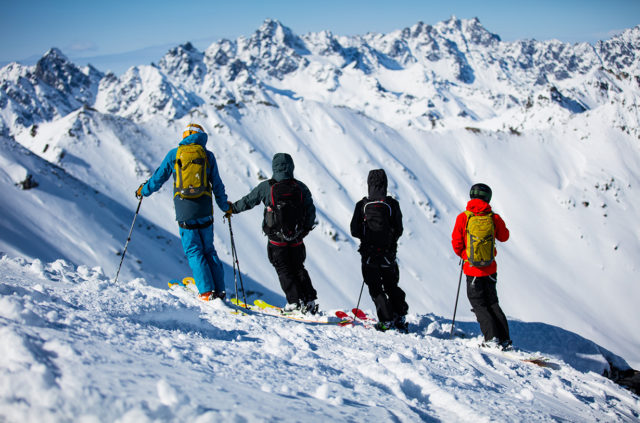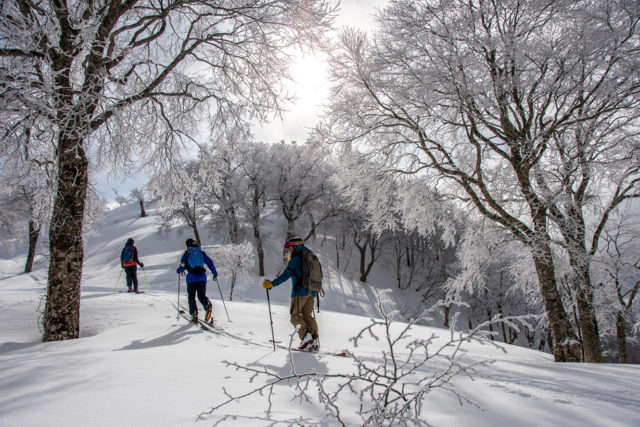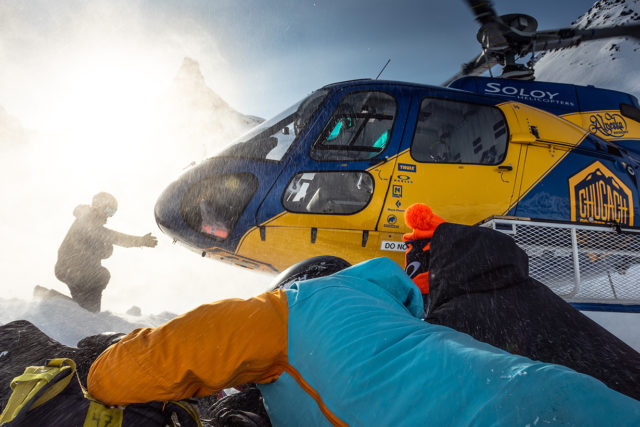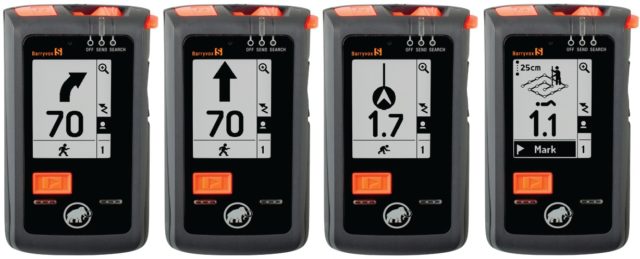Mammut Barryvox S
Blister’s Measured Weight:
- Beacon Alone: 208 grams
- Harness system: 90 grams
Stated Features:
- Effective digital search strip width: 70 meters
- Digital receiving range: 70 meters
- Extended search range: extended receiving bandwidth (analog): up to 95 m; Extended search strip width (analog): 100 m
- Circular receiving field: almost identical receiving range for X and Y antennas
- Lithium-enabled: also works with lithium batteries: Less risk of leakage. More stable in low temperatures. Longer battery life (350 hours SEND)
- Display: display with background lighting, very easy to read even when wearing polarized glasses
- Acoustic search guidance: allows the rescuer to visually search the avalanche field
- Reverse direction function to avoid 180-degree search errors
- Group test with clear instructions
- Visual interface: shows distance, direction and number of buried subjects
- Design: ergonomic, impact-proof and break-proof. Can be operated while wearing gloves
- Device tests: automatic self-test and function test
- Smart search interacts with rescuer`s action during the search, making searching simpler and more reliable
- Multiple buried subjects: digital signal processing in the event of several buried subjects
- Buried subjects can be selected from a list, marked (MARK) and unmarked (UNMARK)
- Automatic switching from send to search (Auto Revert): if a rescuer does not move for 4 minutes, we assume a secondary avalanche and the device switches to SEND mode (motion-sensor controlled)
- Rescue SEND: Protective function for non-searching rescuers. In the event of a secondary avalanche it automatically switches to SEND to allow the rescuer to be located
- Auto guidance: device continues to guide the rescuer to the buried subject in the event of signal failures or overlaps
- Vital data: 3D sensor helps the rescuer concentrate his or her resources on the buried subjects with the highest chance of survival
- Advanced search settings: individually configurable search settings: pro search, acoustic and visual guidance; automatic switching from search to send (Auto Revert)
- Alternative search mode (analog mode) helps in resolving demanding search scenarios
- Personalization: start screen and user texts (for example, owner information) can be personalized
- Attachment: includes highly functional Barryvox carrying system
- W-Link: Additional communication channel for improved search performance
- Manage the device fleet via W-Link
- updatable software
- Operating temperature: -25° to +45° Celsius (-13° to +113° Fahrenheit)
Test Locations: Alaska & Japan
Days used: 100+

Intro
Mammut introduced the new Barryvox S and the updated Barryvox last year as a redesign of the popular Barryvox Pulse and Element beacons. Per Mammut, “the new Barryvox® generation continues the faultless reliability that the previous avalanche transceivers were known for. At the same time, we have incorporated some major enhancements in terms of usability and performance. The new Barryvox® generation combines a highly powerful search with intuitive handling to help you find buried subjects quickly, easily and reliably.”

As a longtime user of the original Pulse, I’ve now been using the new Barryvox S for over a year both for recreational and professional guiding purposes. Compared to the Pulse and a variety of other beacons I’ve used, the Barryvox is the best overall avalanche beacon I’ve used. We’ll get into the details below but I first want to address a few important points.
Do you need a new avalanche beacon?
While awareness of avalanche education and equipment is probably at an all-time high, the gear itself is not nearly as sexy to most people as the latest skis, boards, and boots. To my observation, most of us tend to acquire a beacon, use it every day all winter, store it responsibly (batteries removed during off-season please!), and start up the next season without a lot of thought as to whether we need to replace it. This is generally okay in many cases, but I want to highlight a couple of important points.
(1) How many antennas does your beacon have? All modern avalanche beacons that I know of use a system of three antennas. I’m not going to jump into the physics of how the beacons use the different antennae for their various functions, but I hope it will suffice to say that everyone should be using three-antenna beacons. They work much better both in send and receive mode and I have yet to hear a good excuse for someone still dragging around a beacon that doesn’t have three antennas.
Ski gear is expensive overall and the small price to pay for a modern beacon is just part of the entry and maintenance fee for backcountry skiing. And please don’t donate your old beacon to your friend who is just getting into the sport. Used skis, boots, and bindings might be fine, but old outdated beacons are not. I’ve talked with quite a few avalanche professionals about this, and there has been unanimous agreement. My guiding company and all others that I’m aware of require anyone using their own personal beacon to have a modern three-antenna model. They simply work better and faster, and everyone should use one. And yes, I’ve spent years using older beacons dating back to the old blue Ortovox F1, and I know that, with a lot of practice, it’s possible to be fast with an old beacon. It’s also possible to be even faster with a new one. Having an outdated beacon is not a sign of credibility and experience, it’s a sign of not being as prepared as you could be to rescue your partners while they asphyxiate.
(2) How old is your beacon? Not only does new technology make older beacons obsolete, but beacons can lose their effectiveness over time. We all (hopefully!) do a bunch of beacon practice every fall and then again routinely throughout the winter. I personally have noticed changes in range and accuracy of older beacons. My understanding is that this is often due to slight tweaks or warps in the antenna, and is just another example of why it’s imperative to consistently practice with your beacon.
(3) How old is too old? The guiding company I work for, our local avalanche school, and other guiding operations I know of all require that participants retire their beacons if they are 10 years old or older. Regardless of its age, if you notice that your beacon is losing range or accuracy while practicing, contact the manufacturer and stop using it until they respond.
Practicing
I’m going to refer a lot to beacon practice and familiarity during this review, and I wanted to take a moment to emphasize this point. For many years I found myself among those who do one or two practice sessions at the beginning of the season, then just go skiing for the rest of the year without much thought to my beacon skills. Now that I regularly do timed beacon drills and have had to do my share of formal testing, I realize how naive I was for all of those years.

While beacons seem like relatively simple electronics compared to other devices that we use on a regular basis, beacons also require extensive time and training to master. The adrenaline and distraction that accompanies a real-life avalanche rescue make it even more important that we all possess an in-depth knowledge and aptitude with our beacon of choice. Personally, once someone has completely mastered the basic and advanced functions of their beacon, I recommend at least monthly timed multi-burial scenarios that include some component of shoveling practice.
Size and Form
The Barryvox S is smaller and has a different button layout than the original Pulse beacon that it replaced. Instead of the two side buttons on the original, the S uses a combination of an up and down style toggle on the right side and single “mark” button on the front just under the display. The display itself is now quite a bit larger and I find it easier to see in a variety of lighting scenarios. With it’s slightly more compact dimensions, the Barryvox S is one of the nicer beacons I’ve used for carrying in an appropriate (zippered with a place to attach a leash) pocket.

My Barryvox S comes in at around 208 gram without the harness. This is within a few grams of the weight of both my old Barryvox Pulse beacons and the more basic new Barryvox.
Batteries
The Barryvox S will automatically identify if it has alkaline vs lithium batteries in it and configure itself accordingly. This is refreshing for those who prefer to run lithiums (which are marginally lighter and better in the cold) as many beacons in the past did not allow this.
Battery life on the S is as good as any beacon I’ve used. Even with daily use and occasionally leaving it on overnight, I have to change batteries once per year at most.
Range
Mammut claims that the Barryvox S has a search range of 70 meters in standard search mode and up to 100 meters in the professional setting “Search+” mode option.
In the standard search mode, I have compared the Barryvox S side-by-side on a number of occasions with the older Barryvox Pulse and have definitely noticed an appreciable difference in how far down the simulated slide path I have to be to pick up the first signal. In my experience, the Barryvox Pulse was not one of the longest-range beacons (stated range of 50 m in standard mode) whereas the new Barryvox S is pretty close to the best range I’ve found when doing a limited number of side-by-side comparisons with the Pieps DSP Pro (about the same range as the Barryvox S in limited comparison), the Tracker 3 (a little less range than the Barryvox S) and the Ortovox S1 (less range than the Barryvox S).

It’s fairly easy to toggle into the Barryvox S’s Search+ mode and I’ve played with it many times in practice. I’ve found a small but noticeable difference in picking up the signal early using the Search+ mode. That said, the Search+ mode makes the screen go blank and requires the searcher to follow an analog signal initially on sound alone, and then the screen will eventually turn back on once the signal gets strong enough. As a result, the Search+ mode requires much more practice and experience.
It’s also worth noting that, while Mammut recommends holding the beacon up by the ear during the initial signal search and rotating it to alter orientation and pick up a signal faster, I have gotten into the habit of holding the beacon screen-side down (toward the ground so I don’t get distracted and slowed down doing my signal search) and maintaining the same orientation, then flipping it over when I pick up the first signal. I’m sure that Mammut knows what they’re doing when recommending the former approach, but having the beacon in front of me and maintaining orientation seems to help me hone in a little quicker on my search direction. It’s possible that I’m giving up a little range though by not doing it Mammut’s recommended way.
Overall, the range of the Barryvox S is excellent and is now in the highest echelon of signal-search range.
Group Check
The Barryvox S has a very nice group-check function that can be set to either five meters (snowmobile or “sledding” setting) or one meter for “touring.” While I’ve always just used “alternative mode” to do an analog-based beacon check for my daily operations in the past, I’ve recently swapped over to the “group check” on the Barryvox S. My primary reason for doing this is the new “Pro Check” function which does an analysis of each transmitting beacons’ frequency, period, and pulse. While it’s partly just interesting to see the differences and possible signal overlap during this exercise, the main advantage of doing it this way is that the S will identify any transmitters that have fallen out of specification. In simple terms, it’s possible that you can pick up on a malfunctioning beacon during the group check, before you head out. As a guide who does a group check almost seven days a week and often has people bring their own beacons, I find this to be a good feature. Since I started using Pro Check this year, I have not identified any malfunctioning beacons, but I suspect that I will at some point.
If you have a Barryvox S and cannot find the Pro Check function that displays the above information, you should make sure to update your software. I received my S over a year ago and it did not come with the updated software that gave the Pro Check display. Speaking of updates…
Beacon-to-Beacon Updates
Another great feature of the Barryvox S is its ability to do software updates from beacon to beacon. With the Barryvox Pulse, updates required having access to a special device and, as a result, it seemed that a lot of people didn’t get the updates on schedule.
It’s much easier with the Barryvox S. For example, when I learned that the S software had an update, I just asked a friend to borrow his new Barryvox S beacon for about 15 minutes and was able to transmit the update to mine without a computer or internet access.
Vital Data & Burial Data
The “Pulse” designation of the original Barryvox Pulse was in reference to sensors in the beacon that detect pulse activity of a buried victim. This feature is retained in the Barryvox S and can be detected by other users of Mammut beacons during the search. This feature can also be turned off. I don’t have strong feelings one way or another on how useful this feature is or how likely it is to affect the outcome of a multi-victim scenario.
Auto-Revert to Send Mode
Like most modern beacons, the Barryvox S and Barryvox will revert to “Send” if they are in “Search” mode but stationary for a fixed period of time. The default setting is four minutes but this can be changed in duration with the S model or disabled completely. This feature exists in case a rescuer is subsequently buried in a secondary avalanche while using the “Search” function.
Single-Beacon Search
In the past, I sometimes recommended a Tracker 2 or 3 to less experienced users because those beacons seemed to process information faster and get on a single victim a little quicker and more intuitively. As it did with the range concerns of the Pulse, the new Barryvox S thoroughly addresses this.
I haven’t done a direct comparison with a Tracker 2, but I am faster in a single-beacon search with the Barryvox S than I am with the Tracker 3. In a scenario where every second can make a difference in the life of a buried victim, the improved and now excellent speed of the Barryvox S is a big deal and I think it’s largely due to two factors.

First, the S seems to just process information much faster than the old Pulse. Gone are the “Stop” messages that often popped up on the Pulse display when moving too quickly for the processor, especially during the fine search. In addition, the fine search is also much faster and acquiring the lowest possible signal is both easier and faster because the user of an S is less likely to outrun the processor by moving too quickly.
Second, the Barryvox S’s display is bigger, easier to read, and more intuitive. The arrows are clear and often illustrate the natural curved path of following the signal in. One feature that I’ve not seen before is the “turn around” arrow icon on the S that tells a user if he is going in the wrong direction. This isn’t a big deal because even the most basic modern beacon instruction has always instructed users to do a 180 if they start getting increased numbers, but I still think it’s a good idea especially in the hands of less experienced users.
Multiple-Beacon Search
Hopefully, no one reading this will ever have to do a single-beacon search, much less a multi-beacon search. But with more and more people in the backcountry, I think that multiple-beacon searching is an important skill for all backcountry users. Many beacons have offered various forms of “marking” functions for at least the past 10 years with varying success.
Throughout the last 20 or so years, I’ve spent a lot of time practicing this skill and adapting my technique to available beacon technology. While familiarity with Mammut’s products probably biases me, my opinion is that the Barryvox S offers the best multi-beacon search function on the market.
The most obvious feature for doing multi-beacon searches is the ability to “mark” or “mask” a signal so that additional beacons can be searched with less distraction. The Barryvox Pulse did this quite well and the new Barryvox S makes it even more intuitive with a dedicated “flag” button on the front of the beacon. Similar to the Pulse, the S also allows the user to toggle through the list of marked beacons, numbered in order of detection and with each beacons distance displayed. You can select which one to search for from the list. This is all fairly intuitive and works well. The only real improvement here over the Pulse is that the S does everything a little faster and with the aforementioned larger and more intuitive display.
It’s worth mentioning that the ability to toggle through the list of beacons identified can be very helpful. In practice with my old Pulse, I routinely noted that it did not always prioritize the closest signal in the list and being able to do a quick inventory sometimes prevented me from going past a closer beacon while practicing multi-beacon searches. So far, my S has always prioritized the closest signal during my practice but it’s nice to know that I can toggle through them as needed. One difficult scenario where this might be useful is if the first signal leads to a very deep burial and a quick check of the list might reveal a very close second beacon buried much more superficially.
The other feature that I loved about my Pulse, and that’s retained in the S, is the ability to utilize analog acoustic tones while in multiple-beacon digital search mode. With some practice, I find that the analog tones really help me create a better mental map of the burial scenario and, in the worst case of signal overlap, I can use the analog tones to figure out how many beacons are buried and, potentially, their relative distances. I find this very helpful, but it does require a lot of practice to take advantage of this function.
Compared to the Tracker 3 or Pieps DPS Pro, I find the Barryvox S more intuitive and faster in multiple-beacon searches. The huge caveat is that I have spent way more time practicing with the Barryvox series than with the other models, but I’ve put all of these beacons in the hands of less experienced users and with a brief tutorial in masking / marking with all of them, I’ve found that most people find the display on the S to be the easiest and fastest.
Barryvox S vs Barryvox
I have also been using the new standard Barryvox, which is the replacement for the Barryvox Element. At around $150 cheaper than the S, the Barryvox shares the same basic shape and layout but lacks many of the S’s features that I’ve expounded on above. The standard Barryvox does still have the ability to mark / mask beacons in a multi-burial scenario, but it lacks the ability to toggle through the different searched beacons. It similarly lacks the group check and analog functions and has a more basic display and icons during the search settings.

Overall, the new Barryvox is a good beacon and will perform all of the necessary functions with relative ease. I could see it being a good option for rentals or for providing to guests in a guiding operation, but I think that anyone else should strongly consider upgrading to the S and learning to use some of the more advanced functions through regular practice. While $150 is a lot of money, ski touring gear in general is expensive and if used on a regular basis, that $150 gets amortized out to almost nothing over the years.
Who’s It For?
While I definitely recommend the Barryvox S as a top choice for professionals and other advanced users, I wouldn’t hesitate to recommend it to any backcountry traveler. With some time learning and practicing, it’s a powerful and intuitive rescue tool.
Bottom Line
After over a year of almost daily use, the Barryvox S has proven to be the best avalanche beacon I’ve used, and is a notable upgrade from the Barryvox Pulse that it replaces.



Great review!
I upgraded from a Tracker 3 to the S this year, and immediately noticed a huge difference. My search times dropped significantly, I am picking up signals 15-20 meters further out than I was with the Tracker 3, and I’m much more confident in multiple burial scenarios. And on top of that, it’s dead simple to use. Only problem is that now I want everyone I tour with to have one as well!
Thanks for the review, Paul!
I’d agree with most of your points on the Barryvox S – I’ve been using one myself ever since I used an upcoming CAA AvSAR course as an ‘excuse’ to upgrade from the reliable old Tracker 2. I’ve had the great performance you mentioned in practice and assessment with both the advanced search functions and the mark function – though I’ve found it does tend to slow down around 6 marked beacons (as you say, though, I never ever ever want to get to this in real life!)
Couple things I’ve heard through the ACMG grapevine up here in Canada: you mentioned there’s no more “STOP” message that pops up any more. While the message isn’t there, apparently the issue with outpacing your beacon is. Especially with weaker signals, the S has been programmed to simply keep you going on your previous track while it attempts to reacquire the signal. I guess this seems to work most of the time anyway, though, and keeps the searcher moving rather than standing around! And I know there’s been some issues with the Pro Check function working with Tracker 3 beacons, but I think Mammut is working on another update for this already.
I’d definitely second (third?) your recommendation both for pros and everyone else though!
Nick
You’ve compared the ‘S’ to the Pulse. I agree with your sentiment to upgrade a beacon before your other gear but I’m curious about the longevity of the Pulse. Is this a beacon you would pass along to a friend just getting into the sport?
Thanks for the detailed review. I appreciate the background and have just ordered an ‘S’ for the 2019/20 season.
I haven’t held one yet, but I’m guessing you meant to write that the Barryvox doesn’t have the Pro Check mode, but I’ve seen multiple references to it having a Group Check mode, and can’t imagine it wouldn’t. Given how well my Pulse has worked out, I’m definitely looking forward to the upgrade, thanks for the review!